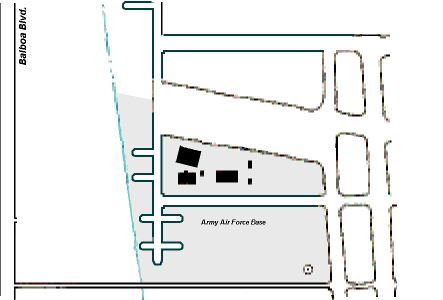
Van Nuys Airport
Army Air Force Base Unit
and
Air National Guard Site
last updated 01/05/2005
Site Plan

Army Air Force Base Unit at Metropolitan Airport
(1942-1945)
1942 - February, U.S. Government acquires 163 acres of the Metropolitan Airport.
Additional 64 tracts of land were purchased on the west side for Army Air Force Base Unit.
1942 - November, U.S. Army constructs the 6,000 foot North South runway and 3,800 foot East West runway.
1943 - August, U.S. Army established 364th Fighter Group, Metropolitan Airport, Van Nuys, flying Lockheed P-38 Lightnings.
12 August 1943 to 11 October 1943
383rd Fighter Squadron (Code N2) P-38 Lightning
384th Fighter Squadron (Code 5Y) P-38 Lightning
385th Fighter Squadron (Code 5E) P-38 Lightning
1943 - October, U.S. Army established
474th Fighter Group, Metropolitan Airport, Van Nuys, flying Lockheed P-38 Lightnings.
1 October 1943 to 4 January 1944
428th Fighter Squadron (Code F5) P-38 Lightning
429th Fighter Squadron (Code 7Y) P-38 Lightning
430th Fighter Squadron (Code K6) P-38 Lightning
1944 - U.S. Army established 441st Army Air Force Base Unit at Metropolitan Airport, Van Nuys, a Lockheed P-38
Lightning Combat Crew Training Squadron (CCTS) base.
441st. AAFBU Box 117
Metropolitan Airport
Van Nuys, California
Training sorties typically involved flights to the gunnery ranges in the Channel Islands. A sub-base was established as Oxnard Army Air Field with a 5,000 ft runway. (Modern day Camarillo Airport, CMA)
373rd Gunnery Training established.
1945 - May, base converts to Northrop P-61 Black Window
training.
1945 - November, U.S. Army Air Force Base Unit closed.
Aircraft
Lockheed P-38
Lightning
(G, H, J and L models)
Northrop P-61B Black Window
Lockheed
Production Service Area: P-80
(1945-1946)
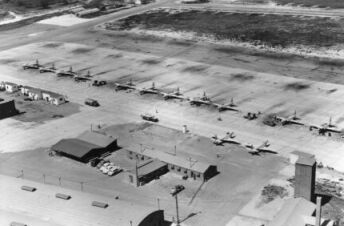
Production Flight Test
P-80
By March 1946, Lockheed had moved its P-80 production flight test from the Lockheed Air Terminal, Burbank, CA, to the vacant Army Air Force Base Unit facilities at Metropolitan Airport.
In September 1946 Lockheed moved its P-80 production flight test to the northeast corner of Metropolitan Airport.
Air National Guard at Metropolitan Airport
(1946-1949)
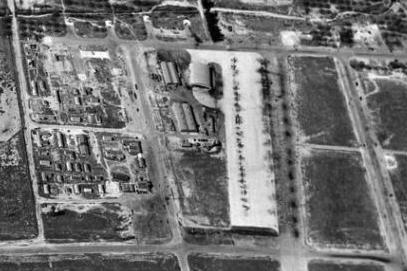
1948 Aerial View (looking west) of ANG Base
at the former Army Air Force Base Unit
facilities
1946 - September 16, the 62nd Fighter Wing, the 146th Fighter Group, the 115th Bombardment Squadron (Light), and the 195th Fighter Squadron were given Federal Recognition, flying out of the former Army Air Force Base Unit facilities.
The 146th Fighter Group and the 195th Fighter Squadron flew P-51D Mustangs at Van Nuys from 1946 to 1948.
The 115th Bombardment Squadron (Light) flew A-26's at Van Nuys from 1946 to 1948.
1948 - the 62nd Fighter Wing, the 146th Fighter Group, the 115th Bombardment Squadron (Light), and the 195th Fighter Squadron moves to Lockheed Air Terminal, Burbank, CA.
The 195th Fighter Squadron (62nd Fighter Wing) returns to Van Nuys ANG base a short time later due to limited ramp space at Burbank, which proved a burden to the Wings mission.
Aircraft
North American P-51D Mustang
Douglas A-26 Invader
Site Plan
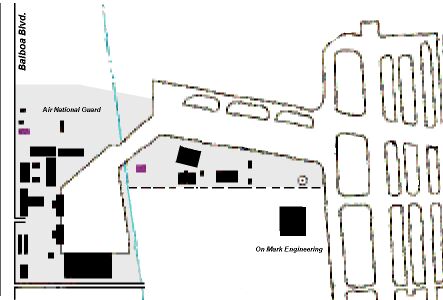
Air National Guard
at
San Fernando Valley
Airport Van Nuys Airport
(1949-1960)
1949 - February, City of Los Angeles purchases the airport from the War Assets Administration for $1.00 and a provision for an Air National Guard facility until 1985. Airport renamed to San Fernando Valley Airport.
1949 / 1950 - The Air National Guard base consisted of the solitary 195th Fighter Squadron left from the 62nd Wing. The 195th Fighter Squadron is equipped with P-51Ds.
1950 - October, the 62nd Wing becomes the 146th Composite Wing.
Apr 1951 - At Lockheed Air Terminal, Burbank, CA, the 146th Composite Wing was activated into Federal Service for the Korean Police action. The 195th Fighter Squadron was left at Van Nuys (not mobilized) to defend the home front.
1952 - New Air National Guard Base completed west of the former WWII Army Air Force Base Unit facilities in preparation for the return of the 146th Fighter-Bomber Wing.
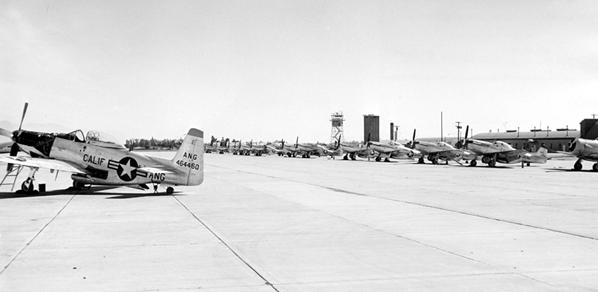
1952 View (looking east) of ANG Base ramp
at the former Army Air Force Base Unit
facilities
On January 1, 1953 the 146th Fighter-Bomber Wing reverted to California state control and ANG status. The wing re-organized to become the 146th Fighter Wing and returned to Van Nuys. The 115th Bomb Squadron (L) became the 115th Fighter Squadron transitioning to F-51H Mustangs.
1954 - February, 146th Fighter Wing begins transition from the F-51H Mustang to the F-86A Sabre.
1955 - May 21, 1st Lt John Conroy of the 115th Fighter Squadron made aviation history by completing the first sunrise to sunset trip between the west and east coast in an F-86A. The 5085-mile round trip between Van Nuys and New York took 11 hrs., 26 min. and 33 sec.

1955 View (looking south east) of the newly constructed ANG Base facilities
By July 1955 the transition from the F-51H Mustang to the F-86A Sabre was complete. The wing was re-designated a Fighter Interceptor Wing with an air defense mission for the Los Angeles area.
1957 - Airport renamed Van Nuys Airport. Runway extended from 6,000 ft to 8,000 ft with Sherman Way underpass.
1957 - 146th Fighter Wing transitions from the F-86A Sabre to the F-86F Sabre.
1959 - 146th Fighter Wing transitions from the F-86F Sabre to the F-86H Sabre.
The 146th Fighter Wing was equipped with 50 F-86 Sabres and a half dozen T-33 jet trainers.
Aircraft
North American P-51D Mustang
North American F-51H Mustang
North American F-86A Sabre
North American F-86F Sabre
North American F-86H Sabre
Air National Guard
at
Airport Van Nuys Airport
(1960-1970)
1960 - The 146th Fighter Wing moved from the attack and fighter mission to that of transport. With air transportation recognized as a critical wartime need, the 146th was selected to receive the C-97 Stratofreighter and was re-designated the 146th Air Transportation Wing (Heavy).
1960 - Two new nose docks built on the west side of the ramp to support C-97 maintenance.
1961 - October, the 115th, the 195th, and their parent units were called to active duty because of the Berlin Crisis and assigned to the Military Air Transport Service. Still based at Van Nuys, they conducted operations world wide in support of the Air Force’s needs.
1962 - August, the Wing and its squadrons were released from active duty and continued to operate out of Van Nuys.
From 1960 to 1970 the 146th Air Transportation Wing (Heavy), later the 146th Military Airlift Wing, flew the C-97 all over the world.
146th Tactical Airlift Wing was equipped with 16 C-97 Stratofreighter cargo aircraft.
Aircraft
Boeing C-97 Stratofreighter
Van Nuys Air National Guard Base
(1970-1990)
1970 - The 146th Airlift Wing began flying the C-130 and was re-designated a Tactical Airlift Wing.
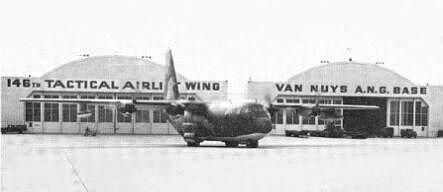
1976 View (looking south) at ANG Base double hangar
In 1976 the base occupied 62 acres of land between the Van Nuys Airport Runways and Balboa Boulevard. The physical plant consisted of 3 large hangars and two nose docks for aircraft maintenance, as well as administrative buildings, supply buildings, shops, and recreational areas, totaling 26 structures. The base had two large aircraft parking areas, taxiways and an aircraft washing area, over 79,000 square feet of concrete pavement.
The base was the home for the 146th Tactical Airlift Wing, the 115th Tactical Airlift Squadron and 14 other operational and support units. It was composed of 1,300 men and women with 300 of them assigned full time.
146th Tactical Airlift Wing was equipped with 15 C-130 Hercules cargo aircraft.
Aircraft
Lockheed C-130 Hercules
Van Nuys Air National Guard Base
(1990)
By March 1990, all but a small remnant of wing personnel had transferred operations to Channel Islands ANG Station. Shortly thereafter, the old Van Nuys facility was closed and turned over to the City of Los Angeles. On April 30, 1990, the flag at Van Nuys ANG Base was lowered for the last time during a special ceremony.
Closed
In February 2002 the large double hangar was demolished.
In March 2004 the World War II Machine Shop Building (Bldg. T507) south of the former World War II ramp was demolished.
On Mark Engineering Co.
7929 Hayvenhurst Avenue
Van Nuys Airport
Van Nuys, California 91406
Located in the southeast corner of the former WWII Army Air Force Base Unit facilities, On Mark Engineering Company was formed in 1954 and specialized in the modification, repair and overhaul of the Douglas A-26 Invader aircraft for the civilian executive transport business.
On Mark A-26 conversions include the On Mark Marksman and the On Mark Marketeer.
In 1962 On Mark undertook the conversion of a Boeing Stratocruiser on behalf of Aero Spacelines, Inc. The aircraft would become known as the B-377PG Pregnant Guppy. The first flight occurred on September 19, 1962 at Van Nuys Airport.
On Mark Engineering Company completed conversion of 40 Douglas A-26 Invaders to On Mark B-26K Counter Invaders for the CIA and the USAF during 1963 and 1964.
In 1965 On Mark undertook the conversion of a Boeing C-97J on behalf of Aero Spacelines, Inc. The aircraft would become known as the B-377SG Super Guppy. The first flight occurred on August 31, 1965 at Van Nuys Airport.
Production
On Mark / Aero Spacelines B-377PG Pregnant Guppy (1 aircraft produced)
On Mark B-26K Counter Invaders (40 aircraft produced)
On Mark / Aero Spacelines B-377SG Super Guppy (1 aircraft produced)
The On Mark Engineering Company hanger was located at the southwest corner of Arminta and Hayvenhurst Avenue.
In the late 1970's through 1982 the former On Mark Engineering Company site was operated by Volpar Inc.
This hanger was torn down in the mid 1980's, one of its last use being the filming of Firefox starring Clint Eastwood. It was suppose to be the "Soviet" hangar from which Eastwood's character steals the Soviet Firefox aircraft.
Related Sites
Feel free to send questions or comments to